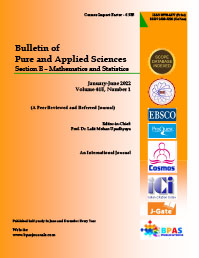A CLASS OF ESTIMATORS FOR ESTIMATING THE POPULATION MEAN AND VARIANCE USING AUXILIARY INFORMATION UNDER ADOPTIVE CLUSTER SAMPLING IN SAMPLE SURVEYS
DOI:
https://doi.org/10.48165/Keywords:
Finite population, study variable, auxiliary variable, Bias and Mean squared error, adoptive cluster samplingAbstract
For estimating the mean of finite population using information on an auxiliary variable we define the classes of estimators under adoptive cluster sampling in this paper. Expressions for their biases and mean squared errors are obtained under large sample approximation. The minimum mean squared errors of each class of estimators are also given. A similar class of estimators is defined for the variance of the estimator of the mean. A condition is obtained under which the proposed class of estimators of the variance of the estimator is minimum.
References
. Chao, C.T. (2004). Ratio estimation on adaptive cluster sampling, Journal of Chinese Statistical Association, 42, 307-327.
. Chaudhry, M.S. and Hanif, M. (2015). Generalized exponential-cum-exponential estimator in adaptive cluster sampling, Pakistan Journal of Statistics and Operation Research, 11(4), 553-574. [3]. Chutiman, N. (2013). Adaptive cluster sampling using auxiliary variable, Journal of Mathematics and Statistics, 9(3), 249-255.
. Chutiman, N. and Kumphon, B. (2008). Ratio estimator using two auxiliary variables for adaptive cluster sampling, Thailand Statistician, 6(2), 241-256.
. Dryver, A.L. and Chao, C.T. (2007). Ratio estimators in adaptive cluster sampling, Environmetrics, 18, 607-620.
. Hansen, M.H. and Hurwitz, W.N. (1946). The problem of non response in sample surveys, Journal of American Statistical Association, 41(236), 517-529.
. Reddy, V.N. (1974). On a transformed ratio method of estimation, Sankhaya C, 36(1), 59- 70. [8]. Srivastava, S.K. (1980). A class of estimators using auxiliary information in sample surveys, Canad. Jour. Statist, 8(2): 253-254.
. Srivastava, S.K. and Jhajj, H.S. (1980). A class of estimators using auxiliary information for estimating finite population variance, Sankhya C, 42 (1-2), 87-96.
. Srivastava, S.K. (1971). A generalized estimator for the mean of a finite population using multi auxiliary information, Journal of American Statistical Association, 66, 404-407.
. Srivastava and Jhajj (1983). A Class of Estimators of the Population Mean Using Multi Auxiliary Information, Calcutta Statistical Association, Vol 32, issue 1-2.
. Srivastava, S. K. (1966). Product estimator, Journal of Indian Statistical Association, 4, 29- 33. [13]. Srivenkataramana, T. and Tracy, D.S. (1980). An alternative to ratio method in sample Surveys, Ann. Inst. Statist. Math., 32(1), 111-120.
. Srivenkatramna, T., (1980). A dual to ratio estimator in sample surveys, Biometrika, 67(1), 199-204. [15]. Thompson (2002). Sampling, Wiley, New York.
. Thompson, S.K. (1990): Adaptive cluster sampling, Journal of American Statistical Association, 85, 1050-1059.
. Yadav, S.K., Mishra, S., Mishra, S.S. and Chutiman, N. (2016). Improved ratio estimators of population mean in adaptive cluster sampling, Journal of Statistics Applications and Probability Letters, 3(1), 1-6.
. Das, A.K. , Tripathi, T. . ( 1978 ): Use of auxiliary information in estimating the finite population variance . Sankhya C, 40: 139 – 148.
